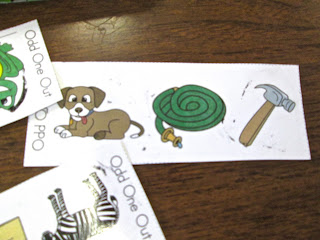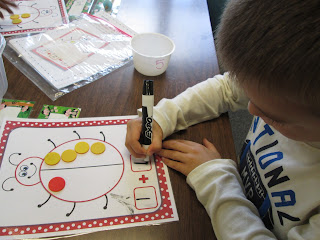We made it through the first month of school! It sure included a lot of self-help skill practice, learning to follow school rules and getting used to the long school day. BUT we are all settled in and ready for the rest of the year! My bees this year are so motivated and ready to learn new things each day. I'm a lucky teacher!
Our first unit for math throws a lot at the new Kindergarteners. We learned counting, comparing, adding and subtracting to 5. (YIKES, it's a lot but we use Math Expressions and the children seem to be understanding the concepts pretty well). Since the unit introduced comparing numbers, I threw in ten frames as I believe they are MIRACLE workers for the young child to understand how to count in order, visually see the way each number below ten compares to the overall quantity of ten, and sets up an easy way to begin looking at number parts. Now, when the time comes that we introduce teen numbers, the children will hopefully understand how teens are made of ten (a full frame) and some more. Place value can be tricky for young minds!
Here's a look at our math lessons and centers!
Investigating number parts and addition using ten frames and cube counters.
Number writing practice (wipe off boards and markers make everything fun!)
Counting is much more fun with purple and green bat counters! For this center, the children had 5 green containers (came free in a classroom sized box of crayons!) At the bottom of each was a number 1-5. The bees were directed to add that number of bats to each green container and then draw how they made that number. So 3 might look like two green bats and one purple bat. Early addition YAY!
These trays come with the Math Expressions program. Where last year I used Scott Foresman for math, I definitely had to get used to the sequence, wording and tools included in my new program. I am still iffy on using these trays effectively. While I LOVE using manipulitives for learning math in the younger grades, these trays take absolutely forever to set up, use, and put away. I'm just feeling as though I'm loosing a lot of instructional time in their set up and dismantling. However annoying this is, they are great for telling the parts of numbers, one to one correspondence, and understanding different combinations of squares are possible and can still make the same amount. We'll be trying comparisons with them next week and I'll let you know how that goes....
One of my favorite centers! Monster Math! This center allows much creativity and fun as the kids choose from six different shapes and collage them together to make their own monster face! When they finish their monster, they are to write how many of each shape they used in the making of their creature. Shape recognition, naming, counting, number writing, and fine motor practice, YES!
We broke out our irreplaceable Lakeshore write and wipe number lines this past week to ensure we are writing our numbers and counting correctly. Here, she is counting some Halloween themed picture, writing the amount and then coloring !
As a warm up one week at the tables, the bees counted for quantity and used their knowledge of one-to-one correspondence. For a few of my bees, this was too easy and so they flipped the paper over and wrote an addition problem to represent the arrangement of the items.
Here's an introduction center to our ten frames. Here, she's discovering that six looks like five and one more, not two more. (Where's her eraser? She's using her fingers....)
Possibly one of my favorite centers of all time. Fun, function, and challenge. Each child receives one of the lady bug forms (laminated!) and an expo marker. They then choose a cup from the middle (you can use this the entire year and make the cups contain more chips). Each of the cups is labeled on the outside with a number and contains that number of double sided yellow and red bingo chips. The children shake them up, spill them onto their ladybugs and separate them based on the colors. Finally, they write how many red+how many yellow and then how many in all. Easy differentiation for any learner. And..... its a never ending center!
This center follows the same idea as the ladybug activity, yet it is a little more challenging as they do not have the divisor of the ladybug's wings. They spill out a cup full of red and black pom poms, replicate the grouping by coloring in circles on their papers, and write the equation that represents the problem.
Beginning of the Year Literacy Centers!
Beginning sound clip for my friends who are already knowledgable on the letters and sounds in the alphabet.
Beginning sound cups
Here, the bees are working on the letters that we have already covered in our letter, sound, keyword phonics during morning Fundations work. They are to find a picture card, say its name, and isolate the beginning sound. Then, they match them and place them into the cup with the correct beginning sound letter.
At this center, the bees are sorting picture cards by the number of syllables in the word. They then draw their pictures under the correct number of syllables. We count syllables two ways. Clapping them out works for most children, but some get confused with word sounds (usually my beginning readers and writers) So instead of getting 1 syllable for "bow" they get three, /b/ o /w/. To help them distinguish syllables, they place their hand underneath their chin and count the number of times their chin moves down when they say the word. Try it!

Beginning sound discrimination. At this center, their job is to circle the picture that does NOT begin with the same beginning sound. So in the picture above, they would circle dog. This proves hard for some!
Upper and lowercase letter identification and matching. Tee shirts for one of my favorite book characters!
Rhyming island! Here the kids are placing two coconuts on the correct island tree that rhymes.
Even the most adept Kindergarteners still get confused with b, d, p and q. In this awesome activity included in the ABC Bootcamp package from Kindergarten Smorgasboard, the children are sorting b, d, p, and q in many different fonts. This is an activity we'll definitely repeat...
Sight word clip and write helps the bees learn the words by spelling, saying and writing the words multiple times.
Here's a look at some of our activities for our Fall Senses Theme!
We read Town House, Country Mouse and sorted things the mice heard versus things they saw. This was an awesome introduction activity to how the senses are connected as many of the bees were arguing that they thought they could see AND hear many of the events that happened in the book.
As we looked more into the sense of sight, we learned that our eyes help us discriminate different colors. We worked as a class to complete this chart and then discussed how we were able to do it, and if we could do it by using any of our other senses. NOPE!
Here's a list of what our apples from a local farm felt like; great adjectives bees!
Compared with some of the other books, like How Apples Grow, this book did a fabulous job of introducing the concept of apples, what people do with them, how many types there are and how they grow on a Kindergarten and first grade level. It even mentions Johnny Appleseed, whom we are a little obsessed with....
And for our final activity? Taste Test!!! The kids heard a story of me traveling to a local farm, picking one of each color of apple and bringing it back to the classroom (which is all true). We talk about taste and what it does to keep us informed, discuss the rules for doing an experiment as a scientist (ask a question, perform the experiment, discuss results, and how to stay safe during an experiment). Then, we eat! We try all three types of apples and then finally graph our favorite. One of the best days of the year by far!
The materials needed to get the kids ready for this "experiment." A red, yellow, and green marker for every pair of students and a paper plate with their names. I allowed the kids to draw their own squares.
We all sit in a circle and I show them the apples and then cut each one separately to give each of the kids one cube to place in the correct colored square for later tasting. What an experiment of delayed gratification!
After we taste test, we graph! Love linking math and science! And of course doing something fun!
some more visual acuity practice
choice time activity- leaf rubbing, being aware of our sense of touch- plus they're beautiful! And easy to make! I simply printed a picture of some different types of leaves and then used fabric paint (in those little squeeze containers) and traced over the lines after laminating the picture. I've used them for three years already and they haven't rubbed off or broken!
AND..... here's a look at some of our classroom I have not yet shared.
Our chameleon themed job chart!
Each morning, the bees are to sit at their desks and write a new story in their journal. The motivation? I bring home the journals every weekend and write back!
We use a morning message every single day in our classroom. I believe these do so much and it reaches the kids first thing in the morning, when they are the most ready and rested to learn. We learn concepts about print like tracking and the parts of a letter and sentence, beginning, middle, and ending sounds, punctuation, number and letter writing, capitalization, some purposes for writing, and so much more. It is here that I sneak in concepts like question marks, blends and digraphs, sneaky e and -ing more as exposure before we cover it later in the year. This is where they do a lot of memorization that helps them to feel like they have some background in some of the most difficult concepts of the Kindergarten curriculum.
Sadly this is the only picture I have from our all about me unit? More will be to come, as we have made self portraits, described ourselves and discovered our true appearance.
We made this (controversial) chart after reading Leo the Late Bloomer. The book is about a young tiger who does not learn at the pace as his friends. He can't read, write, or perform self-help tasks like his friends at school and he feels bad about himself for the beginning of the book. His parents are even worried about his progress. By the end, he learns, in his own good time, all of the skills that his friends are able to do. As we, and every Kindergarten class, have many different levels within our classroom, we spent a lot of time discussing Leo's feelings in the beginning and end of the book. Yes, I let the kids say stupid because I wanted them to feel how badly Leo felt about himself and how he never needed to feel that way because he bloomed in his own time. The kids were very focused and engaged in this activity as it was geared towards how many of them feel at the beginning of the school year. Hopefully it ended by giving them some more confidence and hope for the school year and all the progress they are going to make!









































